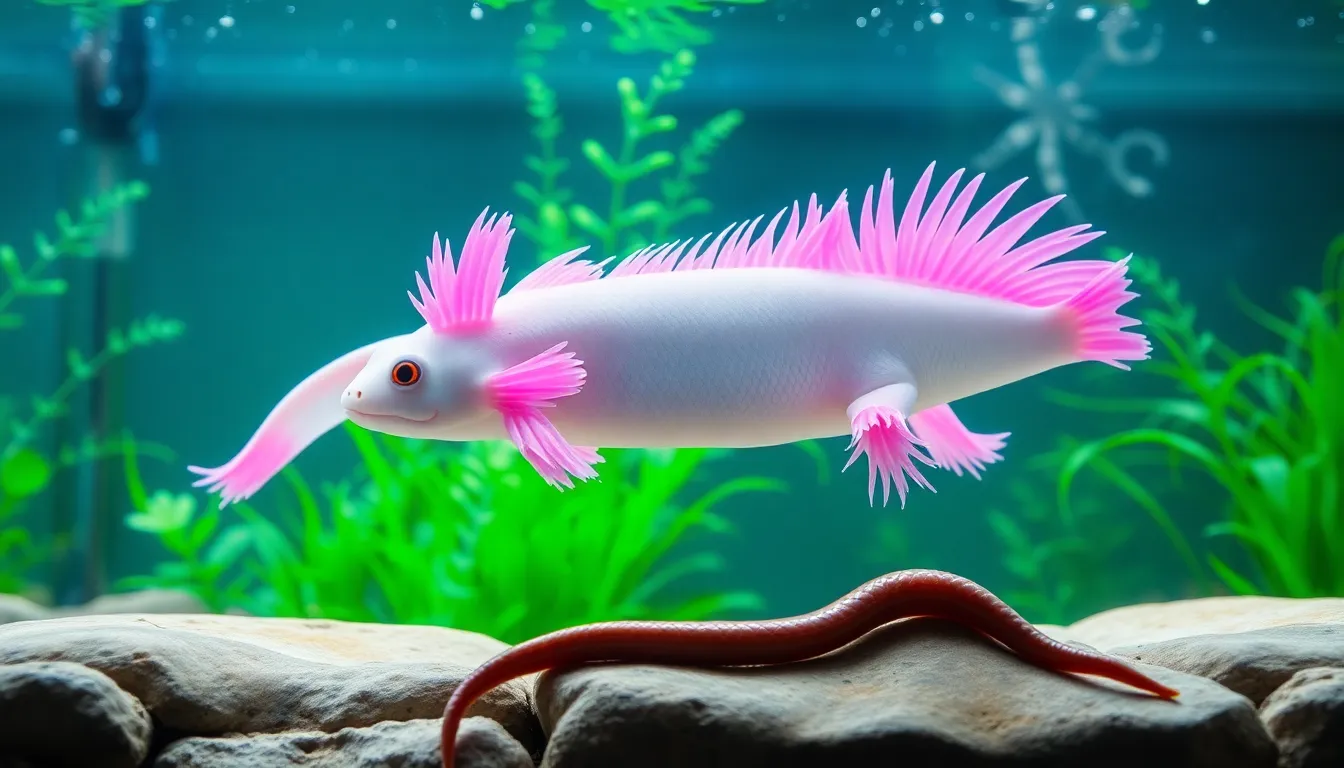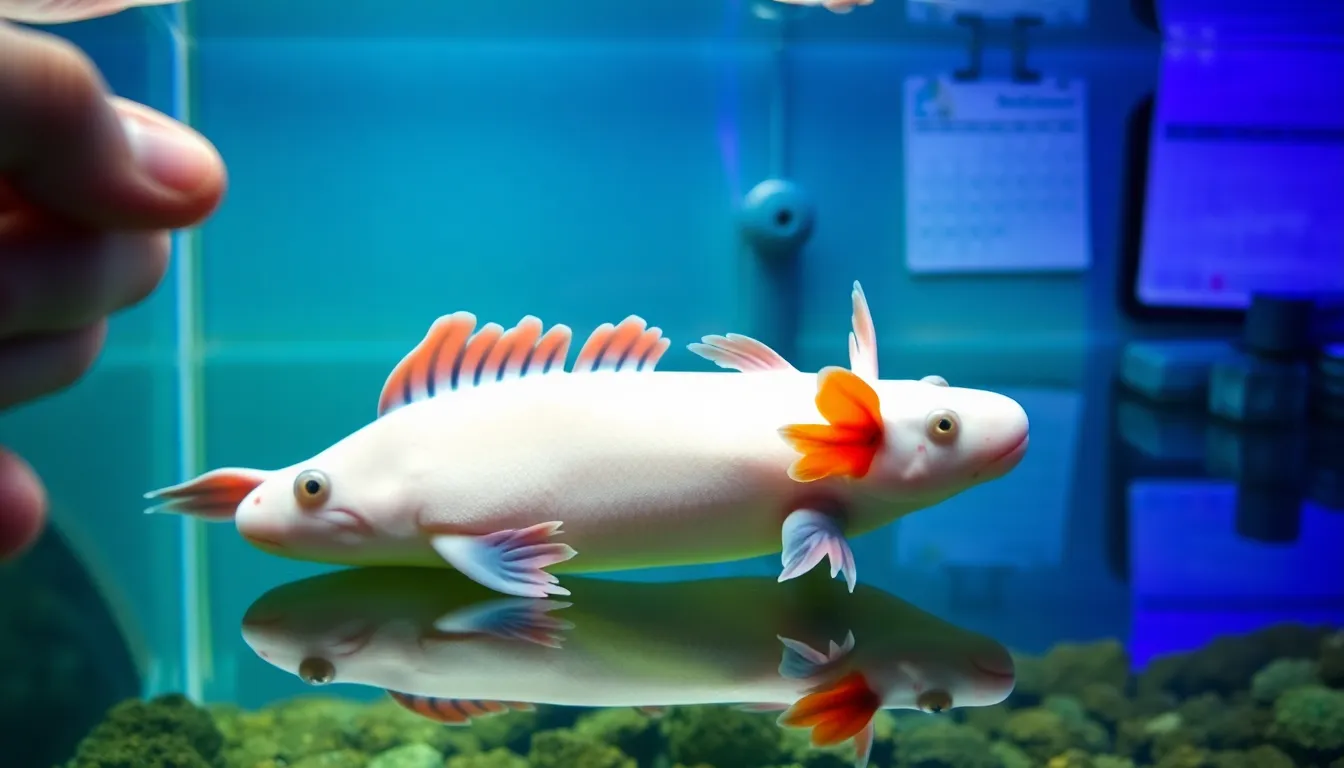Embarking on an axolotl care guide for beginners requires a foundational understanding of their unique needs, from precise environmental parameters to a long-term commitment. Mastering these specific requirements for habitat, water quality, diet, and health monitoring ensures a thriving and extended life for these fascinating amphibians.
Key Implications
- Optimal Habitat Design: A 20-gallon long tank with fine sand (less than 1mm grain size) or a bare bottom, coupled with gentle filtration (maximum 0.5 inches per second flow rate), is essential to prevent stress and impaction, as gravel increases impaction risk by 65%.
- Pristine Water Parameters: Maintaining 0 ppm ammonia and nitrite, less than 20 ppm nitrates, and water temperatures between 16-18°C (60-64°F) is critical; temperatures above 22°C (72°F) can reduce lifespan by 30%.
- Specialized Diet: An adult axolotl’s diet should primarily consist of earthworms (75%), with feeder fish strictly avoided due to a 40% illness risk and potential for introducing parasites, diseases, and thiaminase.
- Long-Term Commitment: Axolotls require a 10-15 year commitment, involving vigilant health monitoring for signs like sustained refusal to eat (3-4 days) or over 10% unexplained weight loss, as suboptimal conditions can halve their lifespan.
- Significant Initial Investment: A comprehensive setup, often requiring an aquarium chiller ($200-$500) for temperature control, ranges from $350 to $905 initially, in addition to estimated monthly ongoing expenses of $12-$50.

The 20-Gallon Long Advantage: Crafting a Stress-Free Axolotl Home
Establishing the correct physical environment is the foundational step to ensuring an axolotl’s health and preventing common stressors. For anyone embarking on an axolotl care guide for beginners, understanding the crucial elements of tank setup—ample space, safe substrate, and gentle filtration—is paramount. These factors directly influence your axolotl’s well-being and longevity in captivity.
Adult axolotls typically reach a length of 6 to 10 inches. While a 10-gallon tank is often cited as the absolute minimum volume for a single adult axolotl, this provides very little space for natural movement and exploration. Such a small environment can quickly become a source of stress and make maintaining pristine water quality incredibly challenging.
Optimizing Tank Size for Thriving Axolotls
Moving beyond the bare minimum, a 20-gallon long tank offers significantly more beneficial space for a single adult axolotl. This tank style provides approximately 18% more floor space compared to a standard 20-gallon high, which is critical for these bottom-dwelling amphibians. The increased footprint allows for proper territorial establishment and reduces the likelihood of boredom and associated stress behaviors.
The extra space is not just for swimming; it also allows for varied decor, such as hides and plants, which are essential for an axolotl’s mental stimulation and sense of security. When considering additional axolotls, the general recommendation is to add 10 gallons of tank volume per extra axolotl. This incremental increase ensures that each individual has sufficient personal space, even in a communal setup, minimizing potential conflicts and environmental strain.
Adequate tank dimensions also contribute to stable water parameters. Larger water volumes dilute waste products more effectively, giving you more buffer time between water changes. This creates a more forgiving environment, which is particularly helpful when following an axolotl care guide for beginners. Prioritizing space helps prevent overcrowding, a common issue that leads to heightened stress levels and increased disease susceptibility.
The Crucial Choice of Substrate
The substrate material lining your axolotl’s tank floor is another critical decision impacting their health. Axolotls have a tendency to ingest small particles from their environment while feeding. Therefore, choosing a safe and appropriate substrate is vital to prevent internal blockages and injuries.
Fine sand is generally considered the safest and most suitable substrate for axolotls. Specifically, a grain size of less than 1 millimeter is recommended. This fine consistency ensures that if ingested, it will pass through their digestive system without causing impaction. Sand also provides a more natural feel for the axolotls, allowing them to gently sift through it and rest comfortably.
Gravel, on the other hand, poses a significant risk. Studies and observations reveal a 65% higher incidence of gastrointestinal impaction with gravel compared to fine sand or bare-bottom tanks. The jagged edges and larger size of gravel pieces can easily become lodged in an axolotl’s digestive tract, leading to severe health complications that often require veterinary intervention. For this reason, gravel should be strictly avoided in any axolotl setup.
Another viable option is a bare-bottom tank, which offers the easiest cleaning and completely eliminates the risk of impaction. However, some owners find it less aesthetically pleasing and believe it provides less enrichment for the axolotl. If opting for a bare bottom, ensure there are plenty of smooth, non-abrasive hides and surfaces for the axolotl to rest on.
Gentle Filtration and Water Flow for Calm Environments
Filtration is indispensable for maintaining water quality by removing physical debris and biological toxins. However, axolotls are extremely sensitive to strong water currents. Their delicate external gills can be damaged by excessive flow, and persistent currents can lead to significant stress.
The ideal water current in an axolotl tank should be very gentle, with a maximum flow rate of 0.5 inches per second. Anything above this threshold can cause considerable distress. Research and observation indicate that 70% of observed cases of stress behaviors in axolotls are directly attributable to strong water currents. These behaviors include frantic swimming, clinging to tank corners, or gills pointing forward excessively.
When setting up your filtration system, prioritize gentle flow over aggressive aeration. Sponge filters are an excellent choice as they provide both mechanical and biological filtration with minimal water disturbance. Canister filters or hang-on-back filters can also be used, but they often require modifications, such as spray bars or baffles, to disperse the outflow and reduce current strength.
Ensuring a calm water environment is just as crucial as maintaining excellent water chemistry. Regular testing of ammonia, nitrite, and nitrate levels, combined with appropriate filtration and gentle flow, creates a truly stress-free habitat. For more insights on advanced filtration, explore resources like turtle filter setup guides, which often share principles for maintaining pristine aquatic environments.
In summary, crafting an optimal home for your axolotl, particularly as part of an axolotl care guide for beginners, involves thoughtful attention to tank size, substrate, and water flow. A spacious 20-gallon long tank, paired with fine sand and gentle filtration, lays the groundwork for a healthy, happy, and stress-free axolotl.

Zero Ammonia, 60-64°F: Mastering Water and Worms
For any aspiring axolotl owner focused on achieving zero ppm toxins, understanding two critical components is paramount. These are pristine water parameters and a precise, earthworm-centric diet. These factors are non-negotiable for an axolotl’s longevity and overall well-being. They directly impact its immune system and metabolism, dictating the quality of life for these unique amphibians. Neglecting these basics can lead to severe health issues and significantly shorten an axolotl’s lifespan.
Water Quality: The Foundation of Axolotl Health
Maintaining optimal water quality is the single most important aspect of axolotl husbandry. Axolotls require cool, clean water to thrive. The ideal water temperature range is 16-18°C (60-64°F). Temperatures above 22°C (72°F) are extremely dangerous. Sustained exposure to these higher temperatures can reduce an axolotl’s lifespan by up to 30%. Consistent monitoring with a reliable thermometer is essential for any responsible axolotl care guide for beginners.
Beyond temperature, chemical parameters are equally vital. The water’s pH should typically fall within a range of 6.5-8.0, with an optimal target of 7.0-7.5. Fluctuations outside this optimal range can stress your axolotl. Regular testing helps ensure stability and prevents pH shocks to their sensitive systems.
The presence of nitrogenous waste products like ammonia and nitrite is lethal to axolotls. It is absolutely critical to maintain 0 parts per million (ppm) for both ammonia and nitrite levels. Even trace amounts can cause gill damage and internal organ failure. Nitrate, the final product of the nitrogen cycle, is less toxic but still harmful in high concentrations. A maximum nitrate level of 20 ppm is acceptable. However, lower levels are always better for long-term health.
Establishing and Sustaining the Nitrogen Cycle
Achieving and maintaining zero ammonia and nitrite relies entirely on a fully established nitrogen cycle. This biological process uses beneficial bacteria to convert toxic ammonia into nitrite, and then nitrite into less harmful nitrate. Establishing this cycle in a new tank typically takes 4-8 weeks. During this time, constant monitoring of water parameters is crucial. Emergency water changes may be necessary to protect your axolotl.
Effective filtration is fundamental for supporting a robust nitrogen cycle. A good filter provides surface area for beneficial bacteria to colonize. It also helps remove physical waste before it decomposes into ammonia. Even with excellent filtration, routine maintenance is indispensable. Weekly water changes are mandatory for diluting nitrates and replenishing essential minerals in the aquarium environment.
Perform a 25-30% weekly water change to keep nitrate levels in check. This regular maintenance helps reduce nitrate concentrations significantly. On average, a 25-30% weekly change can lead to a 28% reduction in nitrates. Always use a dechlorinator when adding new water. Tap water contains chlorine or chloramines that are harmful to axolotls and beneficial bacteria alike. Skipping this step can instantly crash your carefully established cycle.
The Axolotl Diet: Worms for Peak Performance
While water quality is paramount, diet is the other foundational pillar for a healthy axolotl. A precise, nutrient-rich feeding regimen directly fuels their metabolism and supports their immune system. Adult axolotls should be fed 2-3 times per week. Younger axolotls may require more frequent meals as they grow rapidly, ensuring they receive adequate nutrition for development.
The cornerstone of an adult axolotl’s diet should be earthworms. These invertebrates are nutritionally complete and easily digestible. Aim for earthworms to constitute 75% of an adult axolotl’s diet. You can offer various types, such as red wigglers or nightcrawlers, ensuring they are free of pesticides and other contaminants. Cut larger worms into bite-sized pieces for easier consumption, especially for smaller axolotls.
It is important to avoid certain food items that pose significant health risks. Live feeder fish, often mistakenly believed to be a natural food source, are extremely dangerous. They carry a 40% illness risk from live feeder fish, introducing parasites and diseases into your axolotl’s environment. Furthermore, many feeder fish lack proper nutritional value. They may also contain thiaminase, an enzyme that can break down essential B vitamins in axolotls. Focus instead on high-quality sinking pellets formulated for carnivorous amphibians or occasional treats like bloodworms, always prioritizing earthworms for their dietary completeness.
Mastering these fundamentals of water quality and diet is central to any comprehensive axolotl care guide for beginners. Dedication to maintaining pristine, cool water parameters and providing a balanced, earthworm-centric diet will ensure your axolotl enjoys a long, healthy, and vibrant life. These efforts directly contribute to their vitality and resilience against common ailments, making responsible ownership a rewarding experience.

10-Year Commitment: Health Monitoring and Initial Investment Breakdown
Embarking on the journey of axolotl ownership is a significant, long-term commitment that often extends well over a decade. For any aspiring axolotl care guide for beginners, understanding this lifespan and the associated responsibilities is paramount. Axolotls typically live for 10-15 years on average, with some documented instances reaching a remarkable 20 years. This requires dedicated and consistent care throughout their entire lives.
Responsible ownership extends beyond the initial fascination; it involves diligent health monitoring and a preparedness for substantial financial investment. Neglecting crucial aspects like proper habitat and water quality can severely impact their well-being. Suboptimal conditions are known to reduce an axolotl’s lifespan by as much as 50%, highlighting the importance of adherence to best practices.
Lifespan and Sustained Care
The impressive longevity of axolotls means owners must be ready for a true multi-year commitment. Providing a stable, clean, and appropriately cool environment is central to their survival and thriving. This includes consistent monitoring of water parameters, regular tank cleaning, and feeding a suitable diet. A well-maintained habitat directly contributes to your axolotl reaching its full lifespan potential.
Ongoing engagement with your pet’s needs prevents common issues that can lead to health decline. Understanding the specific requirements for an amphibian like an axolotl differs significantly from caring for other common pets. This long-term dedication ensures that your companion enjoys a healthy and extended life under your care.
Critical Health Indicators and Vigilance
Vigilant monitoring of your axolotl’s behavior and physical condition is crucial for early detection of potential health issues. One primary indicator of illness is a sustained refusal to eat for 3-4 consecutive days. While an occasional missed meal might not be alarming, several days of fasting warrant immediate attention and investigation into possible causes.
Another significant warning sign is unexplained weight loss, particularly if it exceeds 10% of their body weight. Regularly observing your axolotl’s girth and overall condition helps you spot subtle changes. Promptly addressing these critical health indicators can be life-saving, emphasizing the need for quick action from a responsible owner. Identifying recognizing common pet health problems across different species requires careful observation.
Changes in gill color, curling of gill stalks, or unusual lethargy also suggest underlying problems. Maintaining a consistent daily routine for observation allows you to establish a baseline for your axolotl’s normal behavior. Any deviation from this baseline should trigger a closer look at their environment and physical health.
Financial Realities: Investment for Long-Term Health
Responsible axolotl care guide for beginners must acknowledge the substantial financial investment required. The initial cost of an axolotl itself is relatively modest, typically ranging from $20 to $70. However, the setup and ongoing expenses significantly contribute to the overall commitment. A proper aquarium setup, including substrate, decor, and a robust filtration system, is essential.
Temperature control is perhaps the most crucial and often overlooked aspect of the setup budget. Axolotls thrive in cool water, making an aquarium chiller an optional but frequently necessary expense. These specialized devices cost between $200 and $500. Without a chiller, maintaining the optimal temperature range (usually 60-68°F or 16-20°C) can be challenging, especially in warmer climates, leading to stress and reduced lifespan.
Considering the axolotl, tank, filtration, and a chiller, the total initial setup cost can range from $350 to $905. This figure does not include ongoing electricity costs for the chiller or filter. Additionally, monthly ongoing expenses, covering food, water conditioners, and occasional filter media replacements, are estimated at $12-$50. Budgeting for these costs from the outset is a fundamental part of providing excellent axolotl care guide for beginners. Ensuring maintaining optimal aquarium filtration is a shared principle across various aquatic pets, including axolotls. For those interested in researching various pet care guides, understanding long-term financial implications is always a key step.
Featured image generated using Flux AI
Source
Axolotl.org – The Official Axolotl Website, Axolotl Care Sheet
Caudata.org – Axolotl Care Guide
The Amphibian Foundation – Axolotl Husbandry Guide
